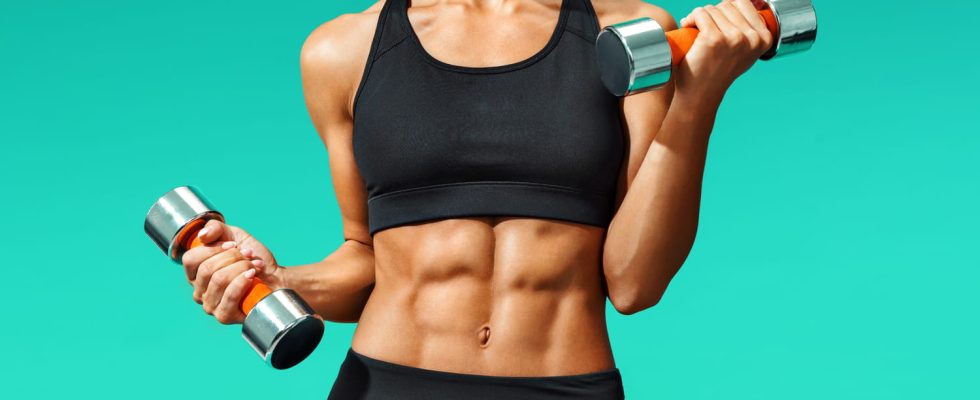In parallel with sports training, some people embark on a “cut” to lose fat mass without losing muscle. When to do it? What sports to practice during the cut?
There dried aims to lose fat mass while preserving muscle mass in order to redefine your silhouette. Tempting isn’t it? But attention. “The dryer takes on a great aesthetic dimension. Its approach (apart from sporting circles) is sometimes complicated to grasp when it comes from a media and social networks. Patients wishing to achieve a dry often identify with public figures and embark on a cutting without being accompanied which can endanger their health” immediately warns Lucas Jaron, dietician-nutritionist specializing in sports. Not everyone can get into a dry and there is some precautions to know. here’s how dry without risk.
Definition: what is a cut?
The expression “doing a cut” refers to the placement ofa specific food behavior for éeliminate fat mass without losing muscle mass. This diet reveals the muscles and sculpts the silhouette.
When to dry?
In the world of high-level sport by weight category, cuts can take place over a relatively short period of time when approaching a goal. “For non-professional athletes, mainly in the world of bodybuilding, the duration depends on the objective of the person and of the time they allow themselves. We define tailor-made programs according to the biological parameters of the person and their objectives while ensuring their health. In general, we define a percentage of weight loss over a period of time that can be counted in days or weeks“replies the dietitian-nutritionist.
What foods to eat to get cut?
When cutting, it is important to pay attention to control weight loss to avoid losing weight too quickly and prevent deficiencies and possible nutritional deficiencies. We prefer:
- THE vegetables which serve as the basis of the diet due to their fiber content and which allow you to be satiated and prevent cell damage.
- THE protein necessary to nourish the muscles, with a preference for lean sources of animal origin (white meats, fish, eggs)
- THE quality fats for lipid intake : vegetable oils with varied nutritional profiles which are best added cold or steamed
- Still or sparkling water (not too salty)
What foods to avoid when cutting?
To lose fat, it is advisable to greatly limit foods with a high energy density (energy content in relation to the weight of the food) or “empty calorie” foods:
- of the sweet products
- crisps and more aperitif products
- of the ultra-processed foods
- of the sugary drinks
- of the alcoholic beverages
- of the cookies and baked goods
Concerning tea, infusions and coffee, you have to be careful their diuretic effect which promotes dehydration. These drinks must represent 1/3 of the liquid intake per day, the remaining 2/3 are provided by drinking water and water from food.
Examples of meals during a cut
Meals, even during a cut, should be structured and consist ofstarter, main course and dessert.
► Input: a base of vegetables cooked or raw such as a beet salad with almonds.
► Flat: a good density of vegetables by limiting starchy foods, accompanied by a portion of meat relatively lean cooked with olive oil such as broccoli, coral lentils and cod.
► Dessert: A verrine of cottage cheese with fruit red.
What sport to practice during the cut?
In general, the cut accompanies a weight training. “The exercises to be preferred are those whose energy expenditure for a given effort is low. It will mainly beexercises performed over a short period of time with significant rest periods and in an environment with a comfortable temperature. We will avoid, for example, the practice of long-term running or other ultra-endurance tests which could lead the organisms to find themselves in extreme situations and risk discomfort or loss of consciousness. recommends the specialist.
What are the precautions for safe drying?
“The first precaution to take is avoid drying alone but to be accompanied by a health professional. In any case, it is necessary to obtain informed medical advice before starting this process” advocates Lucas Jaron. “The precautions are to be shared on a case-by-case basis, emphasizing the Vigilance on these behaviors and the way in which they are carried out without danger. It will be mostly a question of frequency, duration and intensityall so moderately in a period when the body is in an unusual physiological / metabolic situation“adds our expert.
What are the dangers of a cut?
- a fatigue important
- a weakening of immune system
- cognitive difficulties: concentration, attention…
- the worsening of potential deficiencies up to nutritional deficiencies
- a undernutrition (unknown to the general public)
- risks of injuries
- difficulties of recovery
“We also note psychological repercussions. Some patients are dissatisfied with results after identifying with media personalities. We must not neglect the way in which the dry period is experienced by the patient. Furthermore, as dryness includes a relationship to food and therefore to emotions, the risk of falling into eating disorders” warns our expert.
What are the contraindications of a dry?
All chronic pathologies (cardiovascular diseases, diabetes), certain inflammatory bowel pathologies, pregnancy, cancer treatments such as chemotherapy or periods requiring high concentration (before examinations) are contraindications to the establishment of a cutting. “Additionally, if the patient has medical background may reveal a health riskwe do not recommend drying. In any case, it is necessary to consult a doctor’s advice before starting a dry“concludes our specialist.
No, a dryer is not suitable for eating without sporting activity. If we do a cut, we play sports. Otherwise, we will rather talk of food rebalancing. But even in this case, physical activity is essential. Sport is part of a healthy lifestyle, regardless of individual eating habits.
Thanks to Lucas Jaron, dietitian nutritionist specializing in sports.
